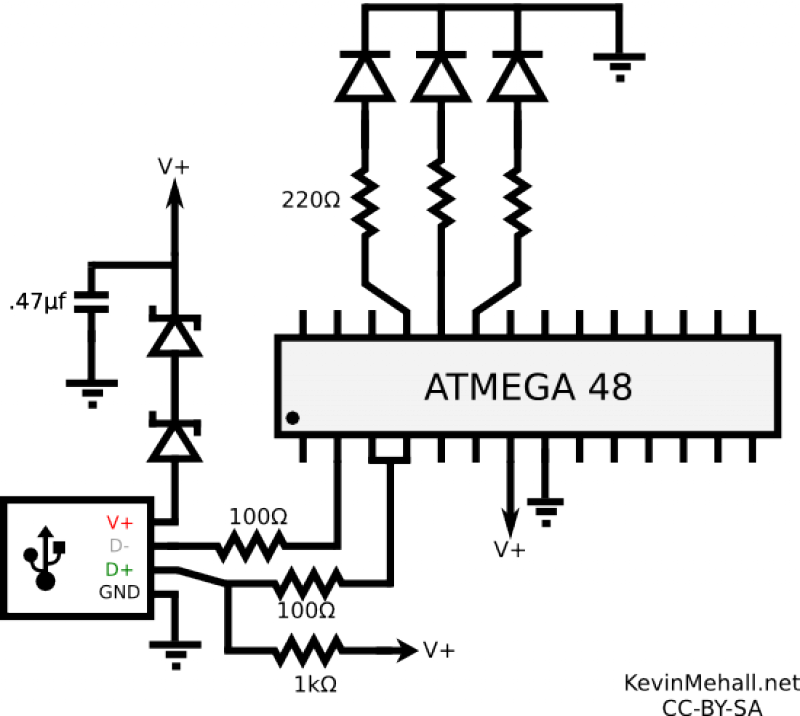
usb controlled rgb led

The article on the RGB LED fader has been one of the most visited articles on this blog. Since its publication, another microcontroller-based RGB LED project has been designed and built, this time controlling the colors from a computer via USB. The AVR microcontroller must be overclocked to run the USB code without a separate oscillator. The osccal.c source file calibrates the AVR internal RC oscillator using the OSCCAL register. This technique was adapted from the V-USB wiki. The host sources are located in the host/ directory. A 32-bit Linux binary is included, or it can be built from source using the provided Makefile. Libusb is required.
The RGB LED project utilizes a microcontroller to control the color output of LEDs based on commands received via USB from a computer. The core of the system is an AVR microcontroller, which is programmed to manage the color mixing of the red, green, and blue LEDs. The project leverages USB communication to receive color data, allowing for dynamic adjustments and real-time control.
To facilitate USB communication, the AVR microcontroller must be overclocked, which enables it to execute the required USB protocol without the need for an external oscillator. The osccal.c file plays a crucial role in this process by calibrating the internal RC oscillator of the AVR. This calibration ensures that the microcontroller operates at the correct frequency, which is essential for reliable USB communication.
The implementation of the USB stack is based on techniques outlined in the V-USB wiki, a resource that provides guidance on creating USB devices using AVR microcontrollers. The project includes host sources located in the designated host/ directory, which can be compiled into a 32-bit Linux binary. For users who prefer to customize their builds, a Makefile is provided to facilitate the building process from the source code.
Additionally, the project requires the use of the Libusb library, which simplifies the USB communication process between the host computer and the AVR microcontroller. This library abstracts the complexities of USB communication, allowing developers to focus on the application logic rather than the low-level USB protocol details.
Overall, this RGB LED project showcases the integration of microcontrollers with USB technology, providing a versatile platform for LED control and color mixing applications. The design emphasizes the importance of calibration and proper configuration to ensure seamless operation, making it an excellent example for those interested in embedded systems and electronic design.The article on my RGB LED fader has been one of the most-visited articles on this blog. Since posting it, I`ve designed and built another microcontroller-based RGB LED project, this time controlling the colors from the computer over USB. The AVR needs to be overclocked to run the USB code without a separate oscillator. The osccal. c source file wat
The RGB LED project utilizes a microcontroller to control the color output of LEDs based on commands received via USB from a computer. The core of the system is an AVR microcontroller, which is programmed to manage the color mixing of the red, green, and blue LEDs. The project leverages USB communication to receive color data, allowing for dynamic adjustments and real-time control.
To facilitate USB communication, the AVR microcontroller must be overclocked, which enables it to execute the required USB protocol without the need for an external oscillator. The osccal.c file plays a crucial role in this process by calibrating the internal RC oscillator of the AVR. This calibration ensures that the microcontroller operates at the correct frequency, which is essential for reliable USB communication.
The implementation of the USB stack is based on techniques outlined in the V-USB wiki, a resource that provides guidance on creating USB devices using AVR microcontrollers. The project includes host sources located in the designated host/ directory, which can be compiled into a 32-bit Linux binary. For users who prefer to customize their builds, a Makefile is provided to facilitate the building process from the source code.
Additionally, the project requires the use of the Libusb library, which simplifies the USB communication process between the host computer and the AVR microcontroller. This library abstracts the complexities of USB communication, allowing developers to focus on the application logic rather than the low-level USB protocol details.
Overall, this RGB LED project showcases the integration of microcontrollers with USB technology, providing a versatile platform for LED control and color mixing applications. The design emphasizes the importance of calibration and proper configuration to ensure seamless operation, making it an excellent example for those interested in embedded systems and electronic design.The article on my RGB LED fader has been one of the most-visited articles on this blog. Since posting it, I`ve designed and built another microcontroller-based RGB LED project, this time controlling the colors from the computer over USB. The AVR needs to be overclocked to run the USB code without a separate oscillator. The osccal. c source file wat
ches the USB frame clock and calibrates the AVR internal RC oscillator with the OSCCAL register. This technique was adapted from the V-USB wiki. The host sources are in the host/ directory. A 32bit Linux binary is included, or it can be built from source with the included Makefile. Libusb is required.
🔗 External referenceWarning: include(partials/cookie-banner.php): Failed to open stream: Permission denied in /var/www/html/nextgr/view-circuit.php on line 713
Warning: include(): Failed opening 'partials/cookie-banner.php' for inclusion (include_path='.:/usr/share/php') in /var/www/html/nextgr/view-circuit.php on line 713





